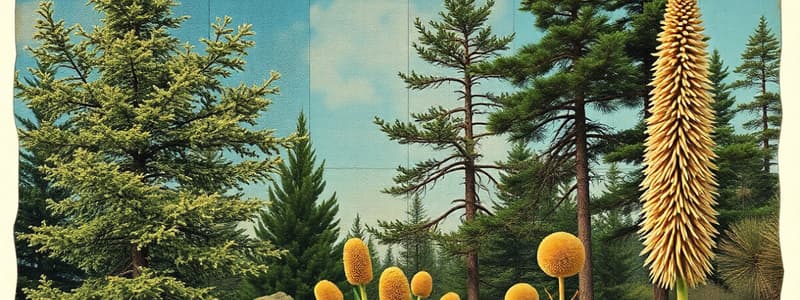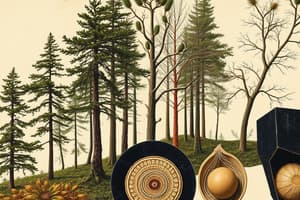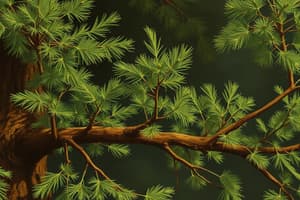Podcast
Questions and Answers
Which of the following characteristics is an adaptation provided by seeds to land plants?
Which of the following characteristics is an adaptation provided by seeds to land plants?
- Ability to perform photosynthesis
- Production of spores for dispersal
- Protective seed coat for the embryo (correct)
- Development of rhizomes for nutrient absorption
Which feature distinguishes gymnosperms from earlier seed plants?
Which feature distinguishes gymnosperms from earlier seed plants?
- Reliance on water for fertilization
- Production of pollen grains
- Development of an embryo
- Exposed nature of seeds on sporophylls (correct)
What adaptation allows conifers to thrive in harsh environmental conditions?
What adaptation allows conifers to thrive in harsh environmental conditions?
- Broad leaves for maximum sunlight capture
- Needle-like leaves arranged in fascicles (correct)
- Production of colorful flowers to attract pollinators
- Extensive root systems for water absorption
What is a key characteristic of conifer wood?
What is a key characteristic of conifer wood?
Which of the following describes a unique characteristic of Ginkgo biloba?
Which of the following describes a unique characteristic of Ginkgo biloba?
How do cycads resemble conifers in their life cycle?
How do cycads resemble conifers in their life cycle?
What feature distinguishes Gnetophyta from other gymnosperms?
What feature distinguishes Gnetophyta from other gymnosperms?
How are Ginkgo seeds utilized by humans?
How are Ginkgo seeds utilized by humans?
Which adaptation occurred during early vascular plant evolution?
Which adaptation occurred during early vascular plant evolution?
What is a key distinguishing feature of Psilotophyta (Whisk Ferns)?
What is a key distinguishing feature of Psilotophyta (Whisk Ferns)?
Which of the following characterizes the leaves of Lycophyta?
Which of the following characterizes the leaves of Lycophyta?
What is a distinctive feature of Equisetophyta (Horsetails)?
What is a distinctive feature of Equisetophyta (Horsetails)?
What is a defining characteristic of Polypodiophyta (Ferns)?
What is a defining characteristic of Polypodiophyta (Ferns)?
How do ferns rely on external water in their life cycle?
How do ferns rely on external water in their life cycle?
Which of the following is a characteristic of bryophytes that helps them prevent drying out?
Which of the following is a characteristic of bryophytes that helps them prevent drying out?
What structural feature is absent in bryophytes?
What structural feature is absent in bryophytes?
Which of the following describes a unique feature of hornwort sporophytes?
Which of the following describes a unique feature of hornwort sporophytes?
According to the binomial system of nomenclature, what rank is directly above the species?
According to the binomial system of nomenclature, what rank is directly above the species?
What is the function of elators in horsetails?
What is the function of elators in horsetails?
What is the Integument?
What is the Integument?
Flashcards
Gymnosperm
Gymnosperm
Plants with exposed seeds, produced on sporophyll surfaces.
Seed Advantages
Seed Advantages
Adaptations enabling land plants to protect and nourish the embryo, provide food, and allow dormancy.
Pinophyta (Conifers)
Pinophyta (Conifers)
A phyla including pines, firs, spruces and cedars.
Fascicles
Fascicles
Signup and view all the flashcards
Ginkgophyta (Ginkgo)
Ginkgophyta (Ginkgo)
Signup and view all the flashcards
Dioecious
Dioecious
Signup and view all the flashcards
Psilotophyta (Whisk Ferns)
Psilotophyta (Whisk Ferns)
Signup and view all the flashcards
Enations
Enations
Signup and view all the flashcards
Microphylls
Microphylls
Signup and view all the flashcards
Megaphylls
Megaphylls
Signup and view all the flashcards
Sporophyll
Sporophyll
Signup and view all the flashcards
Strobili
Strobili
Signup and view all the flashcards
Sori
Sori
Signup and view all the flashcards
Integument
Integument
Signup and view all the flashcards
Softwood
Softwood
Signup and view all the flashcards
Hardwood
Hardwood
Signup and view all the flashcards
Annulus
Annulus
Signup and view all the flashcards
Operculum
Operculum
Signup and view all the flashcards
Frond
Frond
Signup and view all the flashcards
Binomial nomenclature
Binomial nomenclature
Signup and view all the flashcards
Study Notes
Gymnosperms Introduction
- The oldest identified seeds are from the Late Devonian period, dating back over 350 million years.
- Seeds provide land plants with key adaptations like a protective seed coat, food supply for the embryo, and dormancy during unfavorable conditions.
- The first seed plants, originally fern-like pteridosperms or seed ferns, are now classified as gymnosperms.
- Gymnosperm means "naked seed", referring to how seeds are produced on the surface of sporophylls.
- Pollen cones facilitate pollen grain production, whereas female gametophytes grow inside ovules.
Pinophyta (Conifers)
- Pinophyta includes pines, firs, spruces, and cedars
- Conifer fossils' age can be traced back to the late Carboniferous period (290 million years ago).
- Conifers have needle-like leaves arranged in clusters called fascicles.
- Conifers have adaptations to harsh conditions: thick cuticle, sunken stomata, and resin canals.
- Conifer wood is softwood, and consisting entirely of tracheids.
Ginkgophyta (Ginkgo)
- Ginkgo biloba is the only living representative of Ginkgophyta.
- Ginkgos have fan-shaped leaves.
- Ginkgo seeds are enclosed in a fleshy covering.
Cycadophyte (Cycads)
- Cycads have palm-like leaves.
- Cycad life cycles are similar to conifers.
- Cycads are dioecious, having separate male and female plants.
Gnetophyta
- Gnetophyta includes three genera: Ephedra, Gentium, and Welwitschia.
- Gnetophytes have vessels in the xylem.
- Ephedra are shrubby plants found in dry regions.
- Gnetum are vine-like plants, which have large leaves and are found in the tropics.
- Welwitschia is restricted to the deserts of southwestern Africa and has only two strap-like leaves.
Human Relevance of Gymnosperms
- Conifers have edible inner bark and seeds.
- Conifers are used for masts in sailing vessels, crates, boxes, furniture, telephone poles, railroad ties, and mine timbers.
- Conifers are sources of turpentine and rosin
- Conifers are used for fuel, pulpwood, construction lumber, and ornamentals.
- Taxol, a pharmaceutical, is derived from yew trees.
- Ginkgo seeds are edible after removing the seed coat.
- Ginkgo extracts are thought to increase blood circulation.
- Ephedra (Mormon tea) contains ephedrine, which is used for respiratory problems.
Seedless Vascular Plants Introduction
- Internal conducting tissue developed during early vascular plant evolution.
- True leaves appeared during early vascular plant evolution.
- Roots developed for absorption and anchorage during early vascular plant evolution.
- Gametophytes became progressively smaller during early vascular plant evolution.
- Seedless vascular plants include four phyla: Psilotophyta, Lycophyta, Equisetophyta, and Polypodiophyta.
Psilotophyta (Whisk Ferns)
- Sporophytes lack true leaves and roots.
- Stems and rhizomes fork evenly (dichotomously).
- Enations (tiny, green, veinless flaps of tissue) grow along stems.
- Mycorrhizal fungi aid roots which are scattered along rhizomes.
Lycophyta (Ground Pines, Spike Mosses, and Quillworts)
- Lycophytes have plants covered with microphylls (leaves with a single vein).
- Lycopodium (Ground Pines) have stems that develop from branching rhizomes, with sporangia in the axils of sporophylls.
- Selaginella (Spike Mosses) are abundant in the tropics, with leaves having a ligule on the upper surface.
- Isoetes (Quillworts) are found in areas partially submerged in water, and their microphylls are arranged in a tight spiral.
Equisetophyta (Horsetails and Scouring Rushes)
- Sporophytes have ribbed stems containing silica.
- Whorled, scale-like microphylls lack chlorophyll
- Equisetum can be branched and unbranched forms with jointed stems.
- Stomata are located in grooves between ribs.
- Hollow central cavity, carinal canals, and vallecular canals are present in stem anatomy.
Polypodiophyta (Ferns)
- Sporophytes have megaphylls (leaves with more than one vein) that are often large and divided.
- Fern leaves are fronds, which are typically divided into smaller segments.
- Ferns require external water for reproduction.
- Fronds first appear coiled in a crozier (fiddlehead).
- Sporangia may be scattered on the lower leaf surface or found in discrete clusters called sori, protected by indusia.
Human and Ecological Relevance for Ferns
- Ferns are used as houseplants and outdoor ornamentals.
- Rhizomes are cooked as food.
- Used in folk medicine and for thatching houses.
- Used in basketry and weaving.
Bryophytes Introduction
- Developed features reduce drying: fatty cuticle to retard water loss, multicellular gametangia/sporangia surrounded by a jacket of sterile cells, and zygotes developed into multicellular embryos within parental tissues.
- Bryophytes include about 23,000 species of mosses, liverworts, and hornworts.
- Bryophytes can occupy a wide range of habitats, from damp banks to bare rocks and frozen alpine slopes.
- Bryophytes often have mycorrhizal fungi associated with their rhizoids.
- Peat mosses are ecologically important in bogs.
- Luminous mosses are found in caves and other dark, damp places.
- Bryophytes lack true xylem or phloem
- Bryophytes need require external water for sexual reproduction.
Hepaticophyta (Liverworts)
- Most common liverworts have flattened, lobed thalli.
- Thalloid liverworts make up about 20% of species, while 80% are leafy.
- Thalli or leafy gametophytes develop from spores, which may produce protonema.
- Marchantia form gametangia on gametophores (antheridiophores and archegoniophores).
- Riccia is one of the simplest liverworts, with a sporophyte of solely a spherical capsule.
Bryophyta (Mosses)
- There are about 15,000 species of mosses.
- Mosses are divided into three classes: peat mosses, true mosses, and rock mosses.
- Leaves of moss gametophytes are one-cell thick, except at the midrib.
- Mosses have an axis stem-like, without xylem or phloem.
- Gametangia are present at apices of leafy shoots (archegonia and antheridia).
- A mature sporophyte consists of a capsule, seta, and foot.
Anthocerophyta (Hornworts)
- Mature sporophytes look like miniature greenish-blackish rods.
- Gametophytes are thalloid with one large chloroplast per cell.
- Thalli have pores and cavities filled with mucilage containing nitrogen-fixing bacteria.
- Hornworts have a sporophyte with numerous stomata and a meristem that continually increases its length.
Human and Ecological Relevance for Bryophytes
- Pioneer species on bare rock, contributing to succession.
- Retain moisture and reduce flooding and erosion.
- Act as indicators of surface water.
- Used as packing material.
- Peat mosses are used as soil conditioners, poultice material, and fuel.
Plant Names and Classification Introduction
- All living organisms are given a two-word Latin scientific name.
- A Latin name uniquely identifies a species.
- There is one correct scientific name per species.
- Many common names may exist for the same species.
Development of the Binomial System of Nomenclature
- Theophrastus made the first attempt to classify plants in the 4th century B.C.
- Carolus Linnaeus (1707–1778) established the Binomial System of Nomenclature.
- Linnaeus published Species Plantarum in 1753.
- Latin phrases were changed to reflect relationships, placing species in genera.
The International Code of Botanical Nomenclature
- The International Code of Botanical Nomenclature standardizes rules for naming and classifying plants.
- Linnaeus is the starting point for names.
- Rules are revised at international botanical congresses.
- Requires a Latin description of the plant and a designated type specimen in a herbarium.
Classification of Major Groups
- Genera are grouped into families.
- Families are grouped into orders.
- Orders are grouped into classes.
- Classes are grouped into phyla (divisions).
- Phyla are grouped into kingdoms.
- Example: Onion
- Kingdom: Plantae
- Phylum: Magnoliophyta
- Class: Liliopsida
- Order: Liliales
- Family: Liliaceae
- Genus: Allium
- Species: Allium cepa L.
The Species Concept
- Morphological Species Concept: Defined by morphology.
- Interbreeding Species Concept: Capable of interbreeding and reproductively isolated from other groups.
- Ecological Species Concept: Occupies a unique ecological niche.
- Eclectic Species Concept: Uses morphological, geographical, biological, and ecological criteria.
- Nominalistic Species Concept: Species do not exist; the evolutionary unit is a local interbreeding population.
Terms - Bryophytes
- Hydroid: Water-conducting cells in mosses.
- Leptoid: Food-conducting cells in mosses.
- Thalli: Flattened, lobed structures in liverworts.
- Protonema: Immature gametophyte consisting of short filaments.
- Antheridia: Male gametangia.
- Archegonia: Female gametangia.
- Paraphyses: Sterile filaments among gametangia.
- Calyptra: Cap on top of the moss sporophyte.
- Peristome: Teeth under the operculum at the tip of the capsule in mosses.
- Operculum: A lid or flap covering the peristome of a moss capsule.
Terms - Ferns
- Megaphyll: Leaves with more than one vein.
- Enation: Tiny, green, veinless flaps of tissue.
- Sporophyll: Sporangium-bearing leaves.
- Strobili: Cone-like structures bearing sporangia.
- Carinal Canal: Canals conducting water in horsetail stems.
- Vallecular Canal: Air-filled canals in horsetail stems.
- Elator: Aids in spore dispersal in horsetails.
- Frond: Fern leaf.
- Crozier: Fiddlehead; coiled young fern leaf.
- Pinna: Segment of a fern frond.
- Sori: Clusters of sporangia on fern leaves.
- Indusium: Protective covering over a sorus.
- Annulus: Row of heavy-walled cells that catapult spores out of the sporangium.
- Prothalli: Fern gametophytes.
Terms - Gymnosperms
- Integument: Protective layer around the megasporangium.
- Fascicle: Cluster of needle-like leaves in pines.
- Hypodermis: Layer below the epidermis.
- Resin: Antiseptic and aromatic substance in resin canals.
- Softwood: Conifer wood consisting of tracheids.
- Hardwood: Broadleaf tree wood with vessels and fibers.
- Micropyle: Pore in the integument of an ovule.
Studying That Suits You
Use AI to generate personalized quizzes and flashcards to suit your learning preferences.




